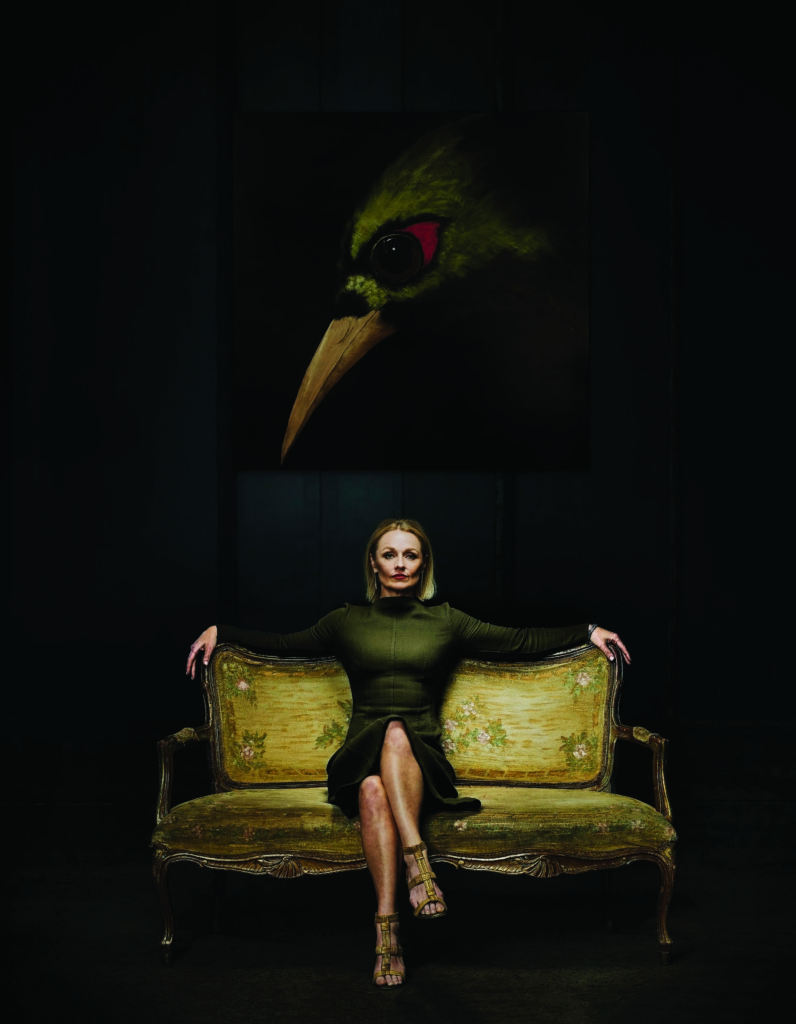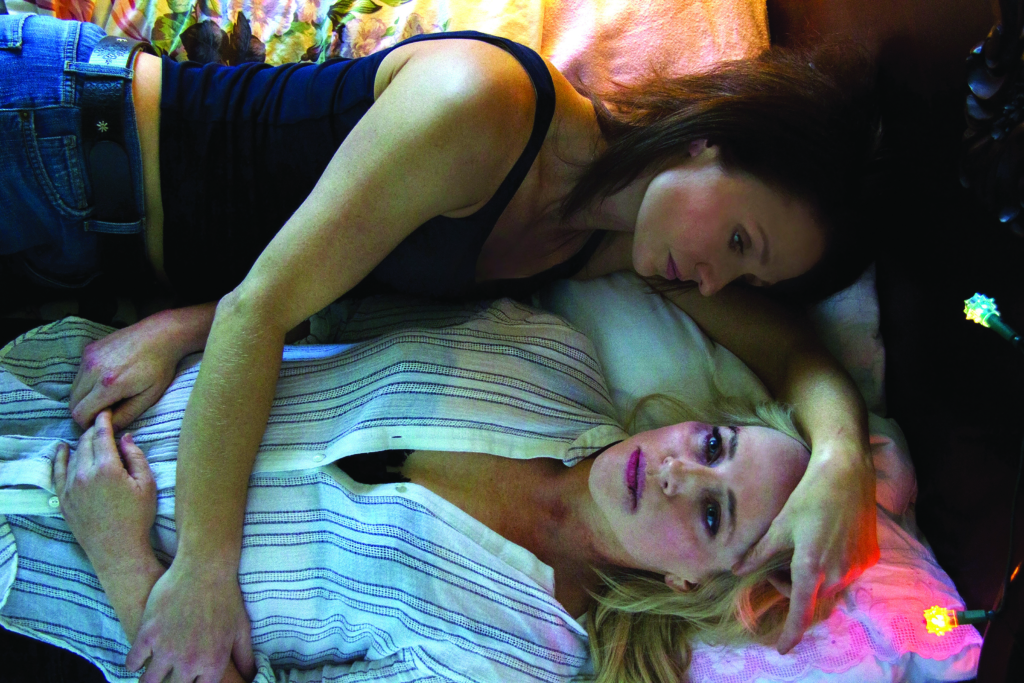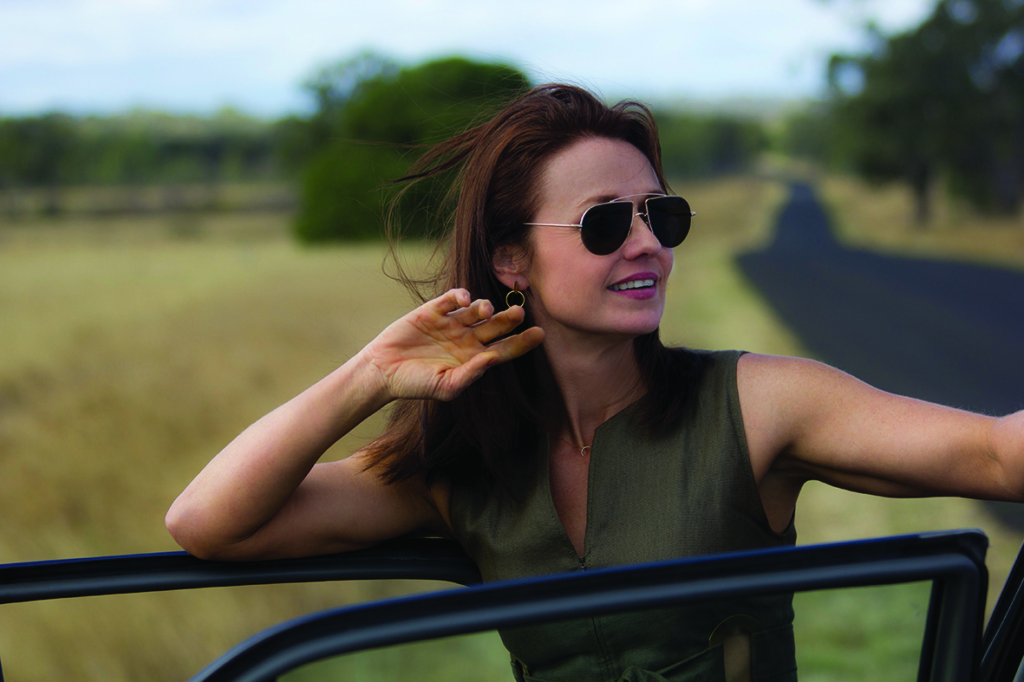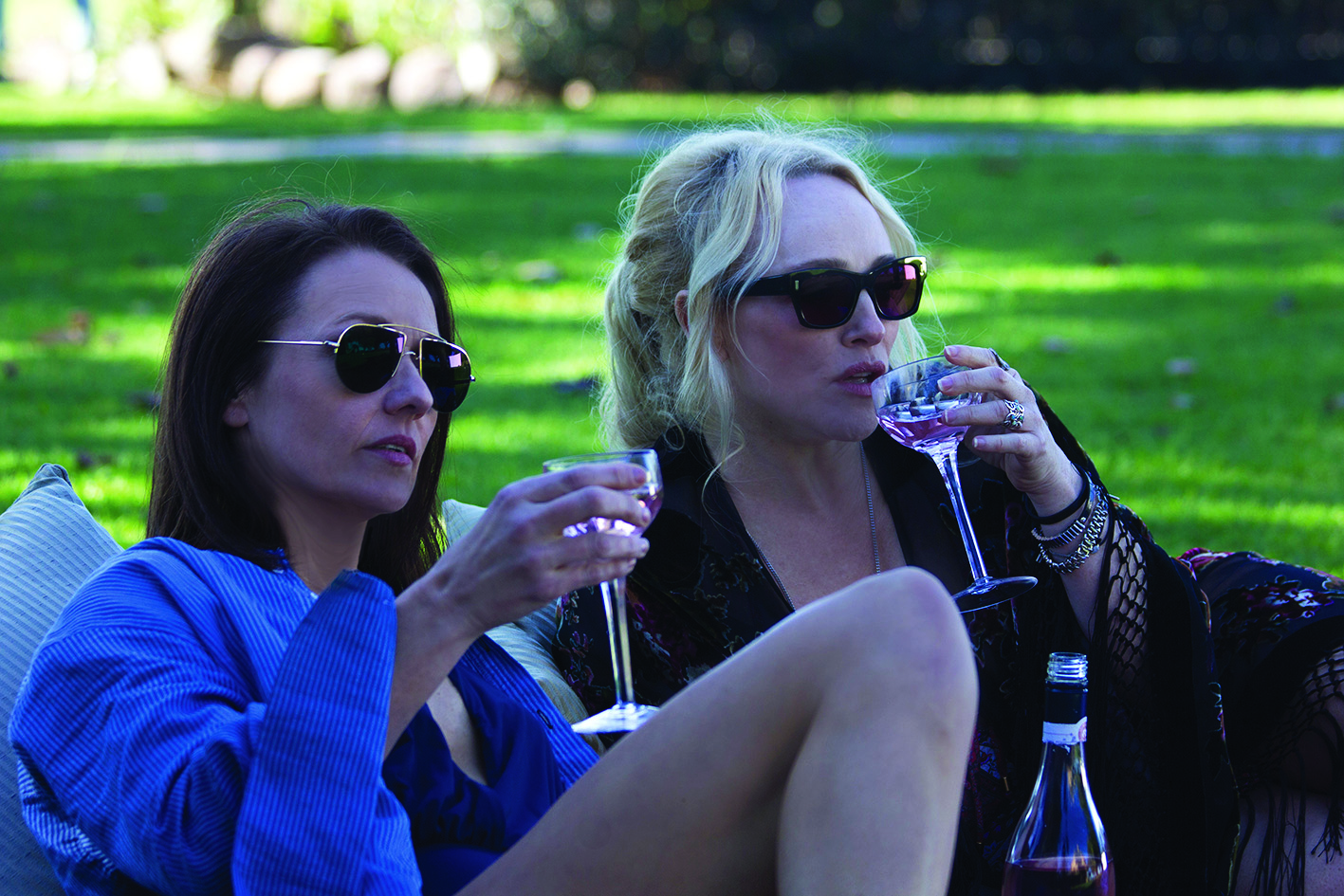Is there such a thing as objective truth, or is it all a matter of perspective? This question permeates every fibre of The Second (Mairi Cameron, 2018), interrogated through both the film’s storyline and the particular way it unfolds and unravels before the audience’s eyes. While the trio of characters on screen pull and trap one another in deeper and deeper lies, ultimately, the greatest trick is that which Cameron plays on viewers. This isn’t one film; it’s three – and which, if any, of these depicts the ‘truth’ is debatable.
The Second begins its multilayered deception from its opening moment. An author is preparing to be interviewed. She’s only got a little bit of time – ‘Press tours …’ she offers vaguely, by way of explanation. ‘You’re in demand,’ the initially gushing interviewer replies. From the conversation, it’s clear that the author is successful. Her first book, an erotic memoir, has garnered awards and acclaim. Her newly released second book, however, has come as a bit of surprise. ‘Something entirely different,’ the interviewer says. ‘The story of a murdered boy.’
We don’t see this conversation; we only hear it. Instead, we are shown white words being typed on a black screen. It’s the kind of thing we’ve grown used to watching at the beginning of a film: the director’s name, producer credits, funding bodies. The words aren’t what’s significant, however; it’s the way in which they’re presented – stylised to look as though they’re being typed out live, complete with blinking cursor and ‘real-time’ corrections and additions to the text. Initially, it seems to be a cute affectation, a nod to the fact that this is a film about a writer. Only later, on reflection, do we see that this is the first hint towards the film’s intention to explore the concept of truth – that maybe it’s malleable, that veracity depends on where you’re standing.

The first real shot we get is brief. As soon as the interviewer says the words ‘murdered boy’, the conversation fades, and the black gives way to a close-up of a young boy, lying still and submerged, as lake water laps over him. After this, the film kicks off properly. To the audience, it seems that we’ve been taken a short way back in time. The Writer (Rachael Blake), riding high on the success of her memoir, heads off to the isolated property where she grew up to start work on her second book. We presume it’s the one we heard about in the interview and, with information being so scant, the questions start arising immediately: Is it fiction or nonfiction? Is it based on real events? Are these events going to happen while she’s on this trip? Or is it, perhaps, something from her past?
The thriller red flags start mounting rapidly. There’s the altercation with a mysterious truck-driving stranger, coupled with the long stretches of Australian country road that are impossible to mentally separate from horror scenarios. There’s the dusty property littered with reminders of an aloof father – complete with disapproving portraits of him staring down from the walls. Then there’s the fact that she didn’t make this trip alone – she’s joined by The Publisher (Vince Colosimo), who is also her lover. When we first see them having sex, he puts his hands around her throat and, when she pulls away, gasping and angry, he says this contradicts what she says in her memoir. They flit between genuine attraction and using each other, and the seesawing power imbalance in their relationship underscores the discomfort already being sown in this film. But The Writer still has things somewhat under control, until an old friend – The Muse (Susie Porter) – decides she’s coming to stay.
‘Just a word of warning: she’s seductive and a devious liar,’ The Writer says to The Publisher before their guest arrives.
A puzzled look crosses his face before he replies. ‘I thought she was your friend?’
‘She is.’
This storyline would have been enough for a good film: three complicated individuals forced to spend a week together, two of whom share a dark secret. The Muse’s presence rapidly brings about big revelations about both books, though we’re never fully sure who is lying. What we do discover is that The Writer’s hugely successful memoir is actually appropriated from The Muse’s life, and a boy really did die on the property, though both women claim it was an accidental drowning. ‘It’s kind of the beginning of a psychological battle between the two women [with] The Publisher caught in the middle,’ Cameron tells me, ‘and, I suppose, as the story progresses, so does the second book.’
The thriller red flags start mounting rapidly. There’s the altercation with a mysterious truck-driving stranger, coupled with the long stretches of Australian country road that are impossible to mentally separate from horror scenarios. There’s the dusty property littered with reminders of an aloof father.
Even when the flashbacks begin, we don’t notice that anything is awry. Yes, they contradict the official story, but that’s just a good mystery framework. It’s only when, during a highly tense scene, the camera cuts away to a shot of The Writer, on her own, narrating events as though she is making them up, that the illusion begins to break down. Did any of the scenes we’ve watched involving the trio actually happen? Or is this all simply the plot of the second book?
The film splits into two. There’s what we presume is the ‘real world’, made up of scenes in which the author is seemingly writing her second book as well as the interview from the beginning, which progresses throughout the course of the film (now showing The Writer instead of just words). Then there is the ‘world’ of that book – the story of The Writer, The Publisher and The Muse unravelling what really happened to the boy. Within this world, tensions are heightening – The Publisher begins to suspect the two women of killing the boy back when they were teenagers, and seeks out more information. The flashbacks grow more sinister: They start with the girls picking up the boy by the side of the road. Then the three of them are at the lake, laughing and having a good time. Suddenly, he’s attacking the teenage Muse. Then he’s dead.
Back in the real world, the interview is starting to come into sharper focus, both figuratively and literally. Whereas, previously, audiences were only shown The Writer, more of the room is gradually revealed in frame and, finally, we see the face of the interviewer, not just a fuzzy outline. It turns out the person asking the questions, no longer gushing, isn’t writing an article about the second book; she’s investigating the murder that lies at the heart of it. The interviewer – actually The Detective (Susan Prior) – brings out the original police reports and a newspaper article about the accidental drowning, then posits that the book is The Writer’s way of confessing what actually happened. This is where the film divides into three: the real world, the world of the book and the flashbacks – with truth and lies creating messy bridges between all of them.

For Cameron, The Second’s script was one that had been hovering around the edges for a long time, which allowed her to get the threads straight in her mind. Asked how she navigated the labyrinth of fact and falsehood, she says:
The creative team all needed to be very clear on ‘this is real’ and ‘this is fiction’ […] We were very careful in defining exactly what our version of that story is, because you can’t really play two things at once.
That said, she isn’t prescriptive about how the film should be interpreted:
The interesting thing about the edit was then taking a bit more licence and juggling how clear we wanted to be about certain things, and how ambiguous we wanted to be giving the audiences enough to solve the puzzle and put the pieces together, but not [so] much that it’s too simple. I love the idea that the audience can choose their own adventure.
Such ambiguity gives audiences a lot to think about – every new detail or question can shift their interpretation of the story. In this way, Cameron’s film is exceptionally well suited for its unconventional distribution model. Following its run at the Sydney Film Festival, The Second was given a limited release in cinemas before being swiftly made available on Stan. While this opens up the film to audiences who otherwise might not have watched it, it also makes multiple viewings more viable compared to what’s afforded by traditional release methods. The Second doesn’t need to be rewatched to be understood, but having the option means audiences can go back over scenes with an informed eye. One viewing makes for a compelling mystery movie; two make for an interesting commentary on truth. ‘It’s a complex little beast, this film,’ says Cameron, with a laugh. ‘You can go down rabbit holes.’

Placing The Writer at the centre of all three ‘realities’ provides an opportunity to explore the ideas of testimony and individual perspective. Though The Muse is present for the boy’s death, we never really get her take on it: whether it was necessary, if it could have been avoided, if it was self-defence. It is The Writer who chooses what goes into the book. She is the one being interviewed. She is the one who ultimately dictates the narrative in all three threads. No absolute truth is presented, perhaps because no such thing can really exist beyond the barest of facts. Instead, we carefully extricate pieces of The Writer’s version of events from the three different realities in an attempt to create a full picture. ‘The author’s eye is on all of this,’ says Cameron. ‘What I hope is that we can still decipher at the end of the film what the truth that she’s cherrypicking in her own life is.’
A lingering key question, however, is: why would The Writer publish such a novel? From what audiences can glean, The Detective is right – it’s a confession. So why take such a risk? The answer, like the film, is revealed in three parts. In the flashbacks, we are shown that The Muse was never given the option to tell her version of events – The Writer and her father decided what the official line would be, and that is what was told to the police. When the film’s title appears in the opening credits, it originally says ‘The Muse’ before being backspaced and corrected to ‘The Second’. The final scene, set in the ‘real world’, shows The Muse approaching The Writer, in what seems to be the first time they’ve seen each other in years, to get her book signed.
Though the film is told from The Writer’s perspective, the story as a whole is about her making amends for what happened to The Muse – for poisoning her life with their shared secret. ‘I’m just so interested in the depiction of a really complex female friendship that isn’t all light and support and “Aren’t we fabulous, loving women with the odd fight?”’ says Cameron.
‘I’m just so interested in the depiction of a really complex female friendship that isn’t all light and support … we do get a sense of the motivation behind the novel. What is driving it, to me, is that [the Writer is] actually exploring and confessing to her own predatory nature as a storyteller.’
Mairi Cameron
[But] they’re not the Single White Female [Barbet Schroeder, 1992] kind of enemies, either. We do get a sense of the motivation behind the novel. What is driving it, to me, is that [The Writer is] actually exploring and confessing to her own predatory nature as a storyteller.
In the end, it all comes back to truth. In the ‘real world’, The Writer silenced her friend, not allowing her to speak about what really happened. Through her book, The Writer is finally uncovering The Muse’s truth – albeit through her own lens. As Cameron explains: ‘Within that second novel, [The Muse’s] story is told. She’s finally released from quite a lot of pain’. Yet these women can’t be neatly filed under either ‘hero’ or ‘villain’, ‘victim’ or ‘survivor’. ‘There are many interpretations, and that’s what we want,’ says Cameron.
They’re both searching. They’re both fighting to be heard in really different ways: one, to find her story as an author […] to step out of the shadows; the other, to be able to talk about an experience in her life.

The film is bookended by The Writer being asked for inscriptions. In the first instance, for The Detective, The Writer is cocky and certain. ‘What would you like me to write?’ she asks, almost sarcastically, before scribbling what is clearly a go-to line: ‘Can’t write without a reader, it’s precisely like a kiss. You can’t do it alone.’ When it comes to the second signing, however, the power dynamic is different. The Writer relinquishes control.
‘Can you sign this for me, please?’ asks The Muse. There’s a pause as the women share a look.
‘Of course,’ The Writer responds softly. ‘What would you like me to write?’





